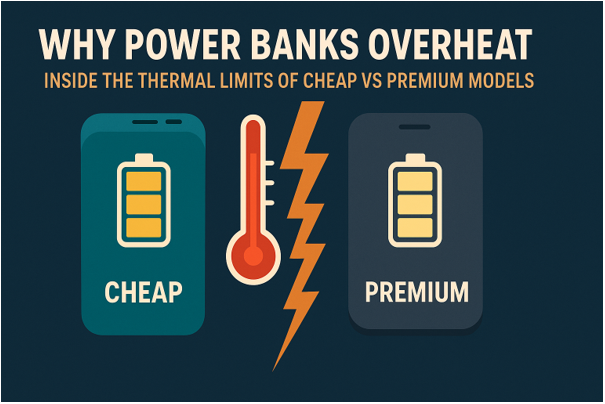In this era of smartphones, tablets and wireless earphones, and other handheld gadgets, a power bank is the new normal. Be it a student of a university who has no time to sit and charge their devices but has to commute between classes or a digital nomad who works in cafes, a good power bank may be the difference between staying online and being offline. However, as they increasingly become relied upon for power banks, there is a serious question: why do power banks overheat? Is this a threat or a sign of bad design?
The problem of overheating is not an insignificant issue. In other cases, it is a safety hazard and can severely reduce the life of the apparatus. In this article, you are going to find out why the power banks overheat and why the budget models are more susceptible to thermal issues, as well as how the high-end power banks are made to be both safe and durable.
Basics: How does a power bank overheat?
Heating of the power banks is mostly a result of the change of electrical energy to the form of heat and the opposition that is experienced when the power banks are being charged and discharged. The interior parts, which are mostly the lithium-ion or lithium-polymer battery, are heat-sensitive, particularly when combined with inappropriate ventilation or improper circuitry.
The major ones are:
High-output charging: Higher-current technologies such as Qualcomm Quick Charge or Power Delivery (PD) produce more heat than regular USB charging, because they deliver more current and voltage.
Low-quality construction materials: Cheap power banks may contain lithium cells of lower quality or have circuit boards that are not well-suited to support extended, fast charging.
Inadequacy of thermal protection circuitry: Most cheap varieties are devoid of internal security measures, such as those designed to check the temperature and thus trigger stoppage of the machine before reaching unsafe temperatures.
All these are aggravated by the exposure to external conditions, such as its powering in direct sunlight or charging when it is packed in a closed bag, thus increasing its internal temperature even further.
The Cons of Cheap Power Banks -The cost aspect. The cheap prices of power banks are due to the risk they pose.
The low price tag of a power bank will tempt you to purchase one priced at $10 or $15, but the price is deceptive as it is associated with safety complications, lack of reliability, and performance.
Lower-grade Battery Cells
These power banks may have cheap power banks that contain recycled cells or Grade B lithium-ion cells. Such cells have already experienced numerous cycles of charge and being repackaged and sold again, and they are very likely to be unstable under stress. Also, the distribution is not uniform, thus giving rise to hot spots, which may cause swelling, spill out, or even burn in your worst-case scenario.
Low Cooling Infrastructure
Budget power banks are usually contained in thin shells made of plastic, which trap heat instead of letting it out, unlike high-end devices, which have heat sinks or well-designed ventilation. It worsens the wear out of internal parts due to poor thermal management.
None Smart Charging Protocols
Smart charging systems control the flow of current according to compatibility, battery condition, and temperature. The relatively low-priced models have a simple power control, and usually, none at all, preventing efficient recharging and resulting in too much heating. Charging can otherwise become flakey without these procedures, and this further adds to the chances of overheating.
Premium Power Banks: The Reason behind their Cool Calmness under Pressure
Thermal performance of the cheap and more expensive power banks is not a matter of marketing, but is reflected in the hardware itself, including firmware.
Quality Cells and Interior Architecture
High-quality power banks produced by Anker, Aukey, and Zendure have high-quality lithium-polymer or tested lithium-ion batteries that display steady capacities and resistance curves. Such quality cells have less probability of thermal runaway, and they are capable of tolerating stress when the charging is carried out quickly.
High-end Thermal Management
Improved designs are real-time thermal sensors and dynamic charging algorithms that change the output with ambient temperature and battery state. In case the power bank begins to become hot, these systems can reduce the rate of charging in order to enable it to cool off, thus preventing dangerous temperature levels.
Heat Dissipating Durable Materials
Exotic products often have aluminum cases, internal cooling gels, and reinforced circuit insulation. With these, they facilitate effective heat conductivity and the avoidance of thermal shock to sensitive circuitry.
Cheap Vs Premium: The Thermal Limit
To describe the differences in thermal control within a model, we will distil some of the main differences.
Thermal safety components:
- Low-cost models: Do not have a thermal cutoff or fuse system.
- Premium models: Thermal fuses, sensor, and regulated ICs are included to end charging when the temperatures exceed.
Charging Efficiency:
- Pricey models: 75-80% efficiency, and thus, bigger heat loss.
- High-end models: 85-95% efficiency, which translates to less heat and long battery life on a single charge.
Asset management of charging speed:
- Budget models: There is uncontrolled heating due to the non-regulation of the output.
- Premium models: Smart output is helpful to keep the desired temperature ranges.
This can be supported by personal experience, and in one case, I used a low-quality power bank running for 12 hours on the train. After four hours, the power bank had a good degree of heat that we could not hold in our hands, and it delivered just two full phone charges, and then it passed away. That is compared to a branded one, which I am now enjoying whenever I use it; it charges faster, it does not get very warm, and it operates very efficiently after a year of usage.
Ordinary Cases That Lead to Overheating
Even high-quality power banks do not escape the heat in the event of poor use conditions. Below are some of the common scenarios in real life that may cause an overload of thermal:
Charging Several devices simultaneously: Getting the maximum power output under extended periods places pressure on the internal circuitry.
Overnight charging: Continued trickle charging once the battery is fully discharged causes stress in the battery.
Charging with a charger: Power banks become hotter when they are being used to charge the gadget and are charged themselves, that is the so-called pass-through charging.
Being subjected to heat sources: Leaving the power bank on the dashboard of a car or engine side may hasten the heating up process, particularly in models that are darker in color.
Knowing these conditions aids in learning to use it in a manner that can extend the period your device can serve you.
Overheating: Prevention and How to Do It
It is not only about purchasing the most exemplary device but also about the habits of the user.
Do not discharge and overcharge: Lithium batteries maximize their performance best when kept at 20 to 80 percent charge.
Avoid charging: Avoid inserting other devices into a power bank when it is charged.
Keep it aerated: They should be allowed to be used outside rather than put inside backpacks and drawers when in use.
Buy quality: If it costs 40 bucks more than a cheap power bank, it is cheap money to make sure that your device stays safe, the battery charges well, and you enjoy a sound sleep.
Conclusion
Competitive market, full of choices, sometimes the difference between an inexpensive power source and a high-end power bank is what goes on under the hood, so to speak, or in this case, inside the case. Starting with the grade of the battery cells and ending with the complexity of the charging algorithms, all aspects affect the way of thermal management. Although the budget models are usually adequate when an individual uses them occasionally, regular use or heavy users are expected to focus on high-quality power banks that value safety.
Knowing about thermal dynamics behind these devices would give you the freedom of making wiser and safer choices, regardless of whether they are school students or campus students in need of reliable power source, a traveler who has to depend on your phone to find directions as you travel, or an individual who attaches importance on performance and durability of your day to day gadgets.
FAQs
Why does my power bank overheat when it is not turned on?
Other power banks have poor idle circuitry, which still acts upon drawing small quantities of electricity, producing heat. They occur more frequently with low-quality models.
Does overheating hurt the connected device?
Yes. When the surge and thermal protection are not built on a power bank, it can get hot, causing spikes that can damage your smartphone as well as your tablet.
Can I charge my power bank at night?
Not always. Whereas the premium ones come with auto cut off abilities, the cheap ones could easily overheat or even fire up should they be left unattended for too long intervals.
What is the right duration of time that a good power bank should serve before it begins to heat excessively?
The best Power Bank must last at least 18-24 months with good usage. In case it is heating up as time goes by, then it is approaching the stage towards completion of its cycle.
Are the high-capacity power banks more likely to overheat?
Not necessarily. It is more based on the quality of internal components and the thermal management system, and not capacity rating.



